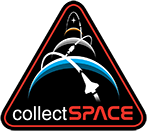quote:
Mementos in time
Crew patches help piece together NASA�s spaceflight history
by Catherine E. Borsché and Brad ThomasThe most highly identifiable symbol for each mission is the crew patch. This patch adorns the crew's flight suits and personalizes the mission story and upcoming mission highlights. Today's astronauts launch with patches of their own design. And while one may just think of the crew patch as a unique identifier, it is much more than that.
"The patch is a big deal to every crew. It's probably the most visibly unique symbol of the mission, usually tells a story about the mission and is often a peek into the personalities of the people onboard," said Steve Robinson, STS-114 mission specialist and patch designer.
"They all have meaning," said Sean Collins, JSC Graphics technical lead. "Some have hidden meanings."
Collins used the STS-72 patch as an example of one with a hidden message. On the patch, a basketball is located in the shuttle payload bay, which represents a crew member who was a former basketball player.
The crew works intimately with the graphic artist throughout the patch design process. Once the crew members formulate a concept, they bring that concept, sometimes in sketch form, to the graphic artist for collaboration. According to Collins, in rare instances the artist might be instructed to create something from scratch for the crew to evaluate.
For the STS-114 crew patch, Robinson personally crafted the initial elements.
"The initial concept took shape over two days in my home studio. I roughed out three to four different concepts using pencil, colored felt pens and watercolor. Only one was really worth taking forward," he said. "I worked for years as a graphic designer as a side job, and I [had] always wondered what it would be like to design a mission patch."
There's a lot of teamwork involved in getting the patch just right.
"Basically, [the design] goes back and forth between the crew and Graphics," Collins said.
Before switching to computers, it would take a graphic artist up to 300 hours to create a patch. However, the genesis of computers has decreased that time to no more than 20 hours.
"The extent to which the patch tells the story of the mission varies widely. Some designs show every major aspect of the mission and crew, while other designs are more symbolic and tend to be simpler," Robinson said.
"For the graphic designer, mission patches present quite a challenge: to uniquely signify a spaceflight in an enclosed shape, using only seven colors and with a lot of text (up to 10 names)."
The most difficult part in the creation of a patch is not the artistic portion, but the approval process itself. Collins indicated that the hardest part is getting everyone to agree, which means approval can take as long as an entire year.
"Once the [crew's] commander says it's good to go, it goes to the ninth floor [in Building 1] and cannot be changed after that," Collins said.
The STS-114 patch had an arduous approval process due to a variety of special factors.
"There were at least 25 revisions. Some of these were due to the fact that the crew was assigned for almost four years before the mission actually flew, and the crew changed multiple times. We actually had 18 different names on the patch at various times," Robinson said. "The major revision was after the loss of Columbia, when we modified the patch design to honor the STS-107 crew and also gained three new crew members on STS-114."
Collins, who has worked on 37 crew patches�including both Return to Flight patches, STS-26 and STS-114�said he thoroughly enjoys his work. "It's a part of history," Collins said. "They are really fun to work on."
The history of the patch is almost as illustrious as the history of the human spaceflight program itself.
Mercury astronauts launched only with the NASA insignia sewn on their suits. The Mercury patches we see today were created after the missions to commemorate those flights.
The first flight to use a patch in addition to the NASA patch was Gemini 4. This crew wore an American flag patch on the shoulders of their pressure suits. Nowadays, the American flag patch is a permanent addition to all the pressure suits worn by American astronauts. Those who fly aboard the shuttle but are not American citizens sport their own home country's flag on their spacesuits.
Thanks to the efforts of Gemini 5 Commander Gordon Cooper, beginning with Gemini 5, all future human spaceflights would have a crew patch that would be designed, partially or entirely, by the crew of the mission. Cooper's patch for Gemini 5 represented a covered wagon, which symbolized the pioneering nature of the Gemini flights.
The crew patch has also grown in popularity with the public. Patches are now considered collectors' items, and many people clamor to obtain them for their personal space memorabilia collections. Not only are they an outward symbol of the crew's identity and mission, but they are also a tangible example of how far we've come in the space program, and where we hope to go one day.
As Robinson said, "Every crew strives for originality, as every crew believes that (its) mission is the most interesting and special mission ever flown!"











